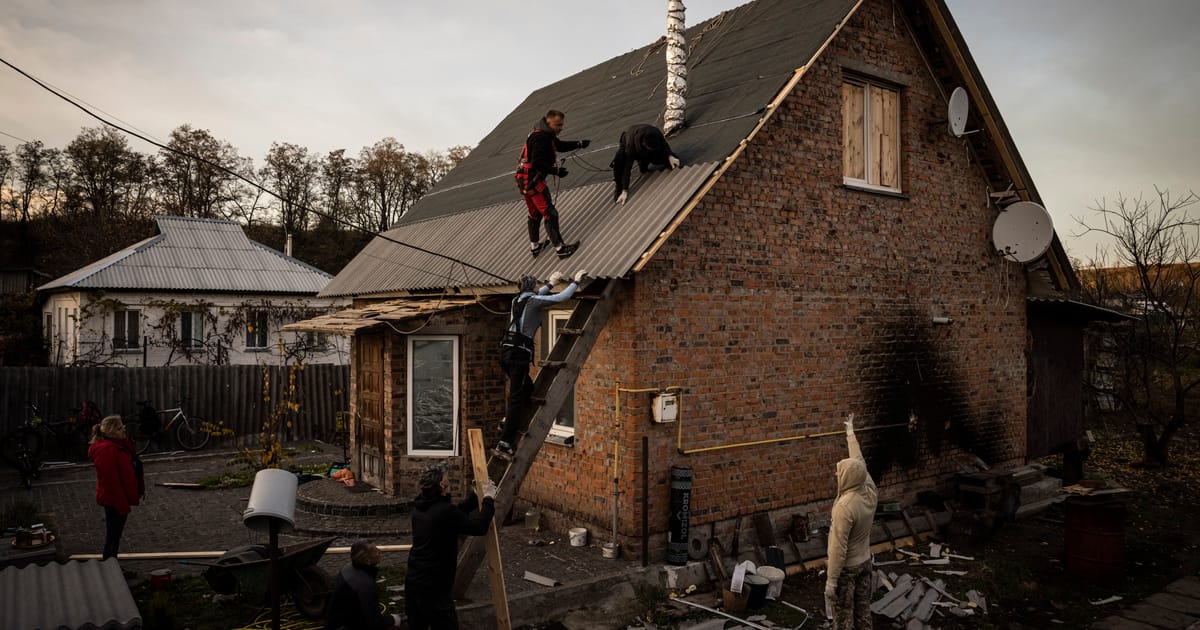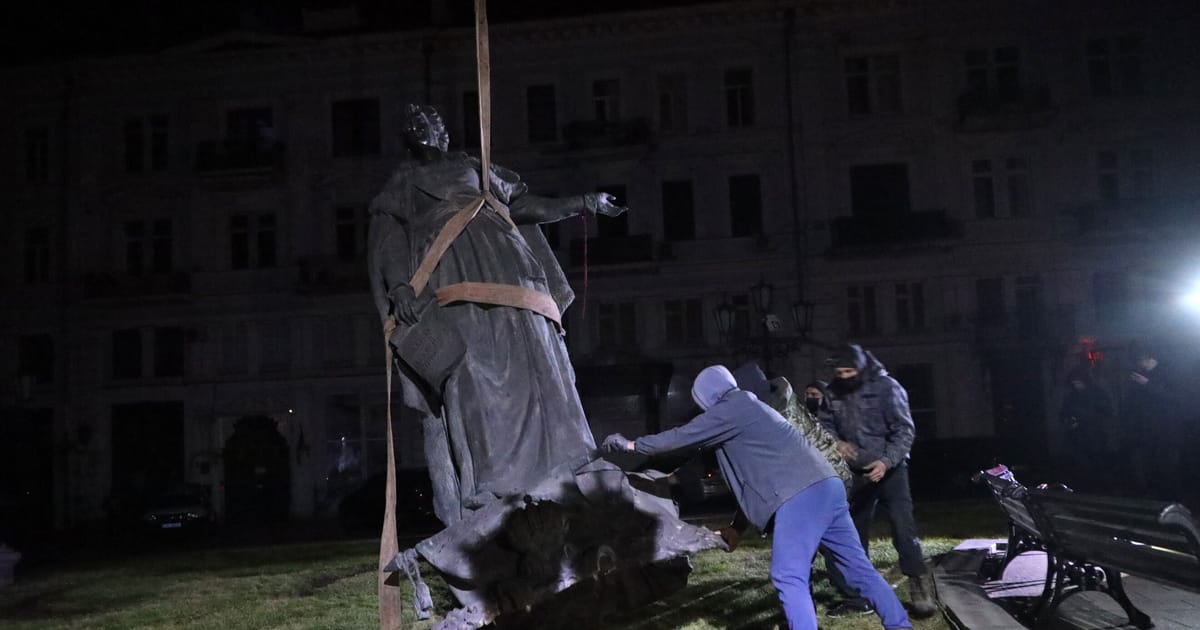LONDON — The European Commission has a plan to help pay for the reconstruction of war-torn Ukraine using Russian state assets. It’s a daring move and a sign of a shift toward something that once looked impossible.
It would be an unprecedented legal feat, one strongly advocated by Ukraine and its allies but which is already kicking up a storm among governments. The EU executive’s intention to throw its weight behind such a move — confirmed by Commission President Ursula von der Leyen on Wednesday — will require some delicate politics over the next few months.
The plan is fraught with political, legal and economic risks. It has consequences for the role of foreign reserves in stabilizing currencies, as well as for the international protection of state property — and potentially could be endlessly litigated in court. The idea of making the aggressor pay for war damages isn’t new, but to go after foreign reserves frozen under Western sanctions would be.
“On one hand, it’s a question of international laws that Russia, as an aggressor, is responsible to pay for damages it’s creating,” EU Commission Executive Vice President Valdis Dombrovskis told POLITICO. “On the other hand, it’s also a question of EU taxpayers’ money. The more we put Russia’s assets towards Ukraine’s reconstruction, the less funding is needed from the EU.”
Sixteen months on from Russian President Vladimir Putin’s invasion, Ukraine is facing a reconstruction bill running into more than $400 billion. While the EU has been at the forefront of pledging support, and the Commission this week requested a top-up of its long-term budget to provide Ukraine with €50 billion in grants and loans through 2027, it’s a tough balancing act as Europeans face a soaring cost of living.
That’s why Commission President Ursula von der Leyen told a Ukraine reconstruction conference in London on Wednesday the proceeds from the over €200 billion belonging to the Central Bank of Russia frozen in the EU will “eventually” be used to pay for Ukraine reconstruction. She said a proposal would be made before the summer break.
The idea of using Russian assets had been floated over a year ago but at the time it looked like a legal impossibility. As the conflict has stretched past its one year anniversary however, signs of momentum emerged.
Financial plumbing
Within days of the invasion in February 2022, the EU, U.S., U.K., Japan, Canada and others froze around $300 billion in Central Bank of Russia foreign reserves.
Over €200 billion of that sits in Europe, mainly in central securities depositories — settlement houses that are part of the plumbing of the financial system — with Belgium’s Euroclear and Luxembourg’s Clearstream holding the largest portions.
These assets generate cash which the CSDs reinvest. While the assets themselves are protected by state immunity under international law, the EU has been looking into how to use the profits.
Other jurisdictions are moving in a similar direction. On Monday, the U.K. announced it would make sanctions permanent until Russia pays war compensation to Ukraine. In the U.S., despite skepticism from Treasury Secretary Janet Yellen, representatives in the House sponsored a bipartisan bill to transfer Russian assets to Ukraine. Canada and Estonia also made legal moves to confiscate assets belonging to persons listed under the sanctions regime.
Uncertainties and reservations
There are two options on the table for the EU, both of which would generate returns of around 3 percent per year, according to an EU Council assessment obtained by POLITICO.
One option suggested by the Commission would be to require holders of the assets, the majority of which have been turned into cash or will do so within two to three years, to invest them, with the EU using the dividends. To go down this route would require “important legal considerations … in light of the principle of state immunity,” according to a document circulated by the EU Council.
The issue is that the EU would be liable to repay Russia in case of losses linked to investment of its state assets. The likelihood of that is low but “remains a concern.”
A second option is to tax windfall profits that the current asset holders are making — largely CSDs, and to a lesser extent, commercial and central banks.
The EU maintains that whereas Russia retains a claim to contractually agreed amounts, extra profits belong to the CSDs and banks, and so could be taxed. The advantage of this option is the EU wouldn’t be liable for losses and as such “carry a lower risk of negative market perceptions.”
The European Central Bank has warned that both options “might raise risks of undermining the legal and economic foundations on which the international role of the euro depends.” The fear is that it could discourage other countries to keep their foreign reserves in euros, as well as put European financial intermediaries at a disadvantage if the EU were to go it alone.
That is why “coordinated decisions with international partners, especially at the G7, would be called for in order to mitigate the risks,” the Council wrote.
The windfall profit tax seems to have gathered more support with “a sufficient degree of willingness to work on that option,” Anders Ahnlid, a Swedish diplomat who chairs EU countries’ talks on the issue, told POLITICO. There was no consensus, he said.
Rich bounty
Ukraine’s most vocal supporters within the bloc are adamant that Russia should pay for damages, and see its foreign reserves as a rich bounty. Poland, the Baltic countries and Slovakia have long advocated for this solution. Nordic countries are also in favor.
“A way must be found to mobilize these assets to offset the cost of reconstruction,” Latvian Prime Minister Krišjānis Kariņš said at Wednesday’s London conference.
In a sign that the issue is gaining credence, it was discussed by EU ambassadors in Brussels on Wednesday.
Envoys from France, Germany, Italy, Luxembourg, Portugal and others expressed doubts and called for further work, two EU diplomats said, having been granted anonymity to speak about confidential talks.
The issue is likely to come before EU leaders at their gather in Brussels next week.
According to draft summit conclusions, they are set to say they “took stock of the work done regarding Russia’s immobilized assets, and invites the Council to take work forward.”
French Foreign minister Catherine Colonna said that tapping Russian assets “poses legal questions that need to be resolved.” But she added: “However, there is a logic that those responsible for the damage are also responsible for paying for the reconstruction in some way. We continue to look for what we should do.”
Suzanne Lynch contributed reporting




